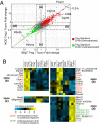The defect in T-cell regulation in NOD mice is an effect on the T-cell effectors
- PMID: 19073938
- PMCID: PMC2604930
- DOI: 10.1073/pnas.0810713105
The defect in T-cell regulation in NOD mice is an effect on the T-cell effectors
Abstract
FoxP3(+) regulatory T cells (Tregs) protect against autoimmunity, type 1 diabetes (T1D) in particular, prompting the hypothesis that a deficiency in Tregs is a critical determinant of diabetes susceptibility in NOD mice. However, tests of this hypothesis have yielded contradictory results. We confirmed that NOD mice, compared with reference strains, do not have a primary deficit in Treg numbers in the lymphoid organs, whether in prediabetic mice of any age or in animals with recent-onset diabetes. NOD Tregs did show a defect in standard in vitro T cell suppression assays, particularly at low suppressor/effector ratios. Gene expression profiling revealed the vast majority of transcripts constituting the "Treg signature" to be normally distributed in NOD Tregs versus CD4(+) T conventional (Tconv) cells, although there were a few differences affecting one or the other population. According to results from criss-cross experiments, the functional inefficacy was not rooted in NOD Tregs, which suppressed as well as their C57BL/6 (B6) counterparts, but rather in NOD Tconv, which were less prone to suppression than were B6 Tconv cells. They also responded more effectively to anti-CD3/28 monoclonal antibody (mAb) stimulation in vitro or to a natural pancreatic antigen in vivo. This difference was independent of autoimmune inflammation, did not map to the idd3 region, and was not due to the overproduction of interleukin-21 in NOD mice. That the immune dysregulation in this T1D model is rooted in the ability of effector T cells to be regulated, rather than in Tregs themselves, has implications for proposed therapeutic interventions.
Conflict of interest statement
The authors declare no conflict of interest.
Figures







References
-
- Anderson MS, Bluestone JA. The NOD mouse: A model of immune dysregulation. Annu Rev Immunol. 2005;23:447–485. - PubMed
-
- Hong S, et al. The natural killer T-cell ligand alpha-galactosylceramide prevents autoimmune diabetes in non-obese diabetic mice. Nat Med. 2001;7:1052–1056. - PubMed
-
- Sakaguchi S. Naturally arising CD4+ regulatory T cells for immunologic self-tolerance and negative control of immune responses. Annu Rev Immunol. 2004;22:531–562. - PubMed
-
- Fontenot JD, Rudensky AY. A well adapted regulatory contrivance: Regulatory T cell development and the forkhead family transcription factor Foxp3. Nat Immunol. 2005;6:331–337. - PubMed
Publication types
MeSH terms
Substances
Associated data
- Actions
Grants and funding
LinkOut - more resources
Full Text Sources
Other Literature Sources
Medical
Molecular Biology Databases
Research Materials

